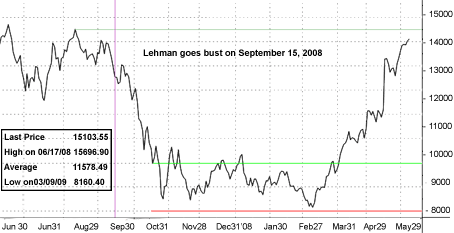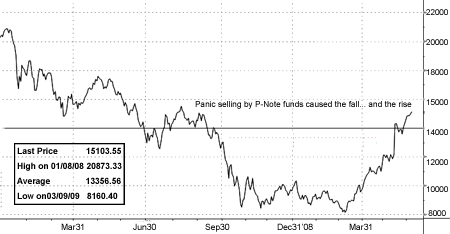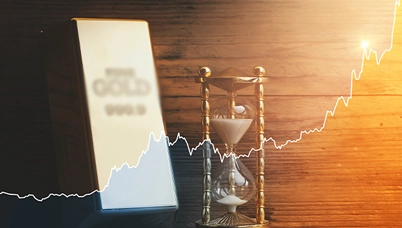The Market's Next Move is 50% - Will the Market Rise or Fall?
Posted On Sunday, Jan 01, 1950
The Indian stock markets have been on a roll.
And everyone wants to know: what next?
Will the market surge +50%?
Or will the market lose -50%?
The BSE 30 Index was stuck in the 8,000 to 10,000 range for 5 months between October 2008 and March 2009. At the 8,000 levels many mutual fund managers and individual investors did not invest. They believed the market could slip to 6,000.
When the market hit 10,000 (5 times in that 5 month period) everyone believed that it was on its way to 8,000. They were right 4 times - each rise of the market resulted in a sharp decline (see Graph 1).
Graph 1: The bankruptcy of Lehman on September 15, 2008 forced the markets into a downward spiral... we are back where we were before that event.

Source:Bloomberg
But, after breaking the 10,000 barrier in March, the market marched on relentlessly to 12,173 on May 15th - the last trading day before the election results.
This rise was so rapid - and against the mainstream thinking - that most people were left out. In fact, many lost money by going "short" - betting that the markets would decline.
Many predicted that Mayawati (uh, remember her?) would be the queen bee and Karat (another name from prehistoric India) the king. That was the assumption for the Index to head all the way down to 6,000.
Now there is no Mayawati or Karat to upset the national political equations. The Index has surged – and after 13 successive weeks of gains - stands at 15,104.
This is 85% above the low of 8,160 reached on March 9th, 2009.
Not only has the uncertainty of a Third Front government been removed, but global capital is willing to take "risks" again and foreign investors are buying India.
Fool's gold
But is India repeating the mistakes we made in the years 2006 and 2007?
There were a few problems with the surge of foreign buying which the Ministry of Finance was blind to. The RBI, to its credit, did send out warnings. But central bankers are treated like the headmaster: every "No" should be defied.
The first problem was much of this USD 17 billion of foreign money that came into India in the year 2007 was mostly speculative money. Not long term capital that large pension funds invest with a 10 year and 20 year time frame. But quick, in-and-out money that hedge funds were happily gambling with. The swine flu of the western capitalist society had invaded India.
The second problem was that this "hot" money was, in many ways, creating a self-fulfilling prophecy. The USD 17 billion that came into India in the calendar year 2007 began to fund highly irrational ventures - like this concept of land banks accumulated by various real estate developers. But the injection of this money itself made the irrational, look rational. Every barren piece of land acquired from illiterate villagers was seen as a glossy township with billions of dollars of future cash flow.
Money illusions can hide the reality underneath - for a while. A surge of liquidity gives the false impression of stronger fundamentals.
Certain banks got more funding and they grew larger - but they grew larger doing the same thing. They are famous for lending to gain market share - with a flawed risk assessment. Just because they got more foreign money to grow, did not mean they were doing the right thing.
Or take a some retail companies - rushing to open malls as if every Indian had buckets of cash to spend every weekend.
Or some motor companies, making certain organisation for future technology - and being able to do so because money was cheap.
The third problem was that, when India did actually face a threat and problem from the global economic crisis and financial meltdown, the policy makers were caught with no clothes. So, when the global crisis hit - India, one of the lesser affected economies - was one of the worst hit stock markets in the world.
A market that can reach a new peak. Now with the elections behind us, the policy makers can act.
The Indian stock markets wobbled from their January 2008 peak largely because of the fears of inflation.
The price of commodities including oil and wheat had surged. India was seen to be a victim of a high inflation environment.
Graph 2: A fall from a peak of 20,873 on January 8, 2008...can we get back there?

Source:Bloomberg
The horizontal line across Graph 2 is the 14,000 level of the Index. If oil had stayed at USD 100 plus; if wheat, rice, and all the other commodities had stayed at their peak levels for a year – one can argue that the market would have fallen by, say, -50%. From its 20,873 peak to a 14,000 level.
But the markets fell to 8,000.
After September 15, 2008 when Lehman went bust.
That is because the foreign hedge funds went scrambling back home with their cash.
And there was no buyer to absorb their vicious selling.
The P-Note holders whacked us on the left cheek; the government offered them all our right cheeks.
Inflation is not a threat to India – or to anyone in the world.
And foreign speculators are rushing to buy back into India: into a politically stable India.
The budget is the next trigger
The election of this new government was the trigger to move the market from 12,000 to 15,000.
The budget to be presented in early July will decide what the markets will do in the next few months.
A "bad" budget will bring the market back to the 14,000 levels.
A "good" budget could take it above 16,000 very comfortably.
A "revolutionary" budget will make it head to 18,000.
And, if companies report better-than-expected profits for the quarter ending March 2010, the market could be at a new peak - irrespective of the budget.
So, if you missed putting new money into the stock market when it rallied from 8,000 to 15,000 – you can still invest. Buy steadily over the next few weeks; not in one shot.
But recognise the inherent ability of stock markets to surge and slump at very short notice – and for very few real reasons.
Moreover, the economic crisis in the world has still not disappeared, though the Indian economy seems even more immune to it today than it did in October 2008.
My advice stays the same: keep aside enough money in "reliable cash" to maintain a lifestyle that you enjoy for 6 months, 12 months, 18 months, or 24 months. That is a function of how you can handle sleepless nights caused by market swings.
Everything else – the money you have left after that – should be invested 80% in equity and 20% in gold.
It is not fun to know that you missed an 85% surge in 5 months. But there is a possibility of a 50% gain in the next 12 months.
Suggested allocation in Quantum Mutual Funds
| Quantum Long Term Equity Fund | Quantum Gold Fund (NSE symbol: QGOLDHALF) | Quantum Liquid Fund | |
| Why you should own it: | An investment for the future and an opportunity to profit from the long term economic growth in India | A hedge against a global financial crisis and an "insurance" for your portfolioA hedge against a global financial crisis and an "insurance" for your portfolio | Cash in hand for any emergency uses but should get better returns than a savings account in a bank |
| Suggested allocation | 80 % | 20% | Keep aside money to meet your expenses for 6 months to 2 years |
Disclaimer : Past performance may or may not be sustained in the future. Mutual Fund investments are subject to market risks, fluctuation in NAV's and uncertainty of dividend distributions. Please read offer documents of the relevant schemes carefully before making any investments. Click here for the detailed risk factors and statutory information"
Ajit Dayal, the author is a Director in Quantum Information Services Private Limited and Quantum Asset Management Company Private Limited. Views expressed in this article are entirely those of the author and may not be regarded as views of the Quantum Mutual Fund or Quantum Asset Management Company Private Limited or Quantum Information Services Private Limited.
Related Posts
-

Understanding GIPS: The Global Standard for Performance Reporting
Posted On Wednesday, Jan 14, 2026
In the world of investing, everyone loves a good performance number.
Read More -

Equity Monthly for January 2026
Posted On Friday, Jan 02, 2026
Indian markets remained range-bound in 2025
Read More -

Gold Monthly for January 2026
Posted On Thursday, Jan 01, 2026
Gold Market Review and Outlook: 2025–2026
Read More



